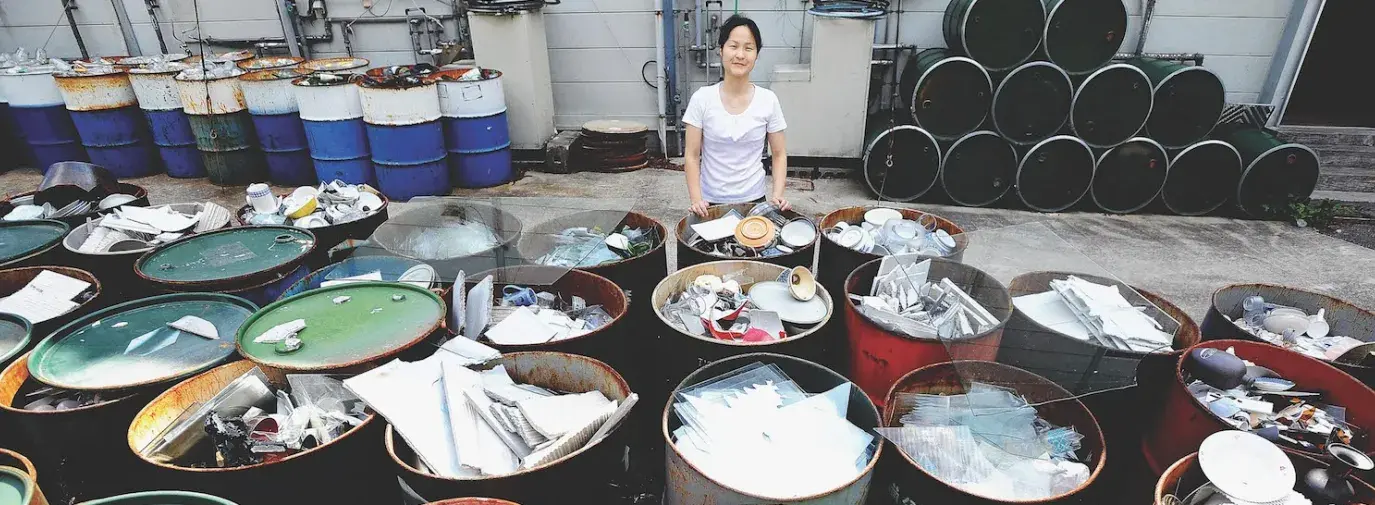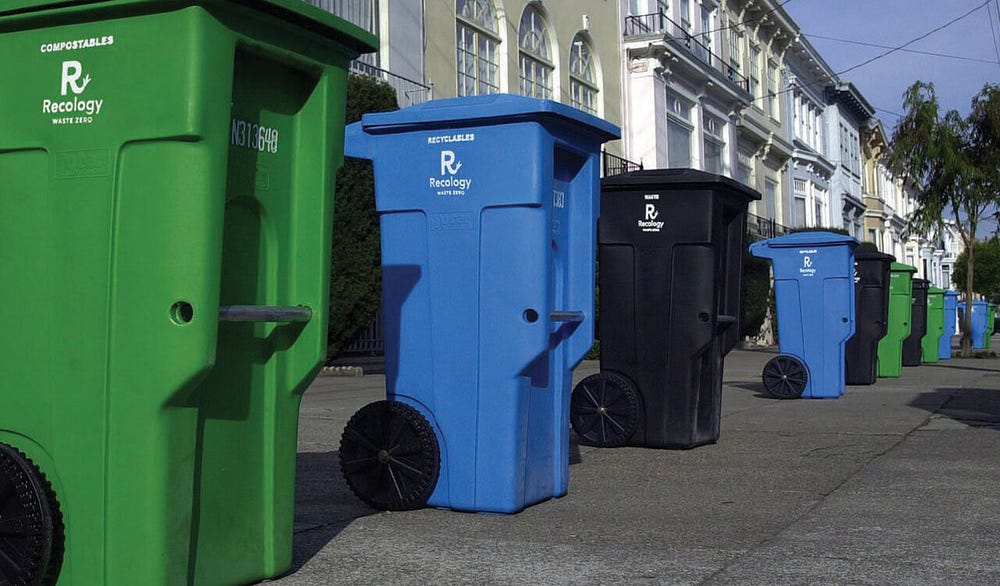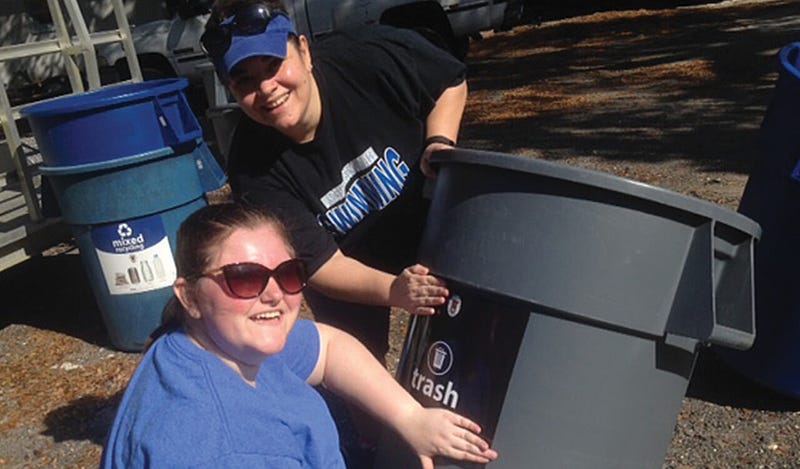
Kamikatsu, Japan, a small mountain town of 1,700 on southern Japan’s Shikoku island, is going zero waste by 2020.
So are a lot of communities in the US. But when local political leaders make this pledge, they sometimes state their city will send “zero waste to landfill” — a phrase meaning that in addition to recycling and perhaps composting trash, the city will still incinerate some of its garbage. Incineration causes air pollution and, ironically, leaves toxic ash behind that must be landfilled.
In Kamikatsu, they mean it: zero waste, no incineration by 2020. Already, the town recycles 80 percent of its trash through a significant commitment and communal effort.
Prior to 2003, this small community used to dispose of its trash through open incineration, according to a short documentary from Discovery Network’s “Seeker Stories.” But burning their trash made residents sick and and the town smell, so in 2003, they adopted the zero-waste plan.
Today, Kamikatsu residents separate recyclables into 34 categories: various types of paper products; tin, steel, aluminum, and other types of containers; plastic bottles; plastic caps; and more.
The townspeople wash each container at home to ensure it’s free from food or liquid residue that can contaminate the recycling process. Then they haul it to the town recycling center, where employees make sure they are sorting items the right way. There’s no municipal trash pickup.
“Classifying the recycling can be difficult,” resident Hatsue Katayama told Seeker Stories. “To wash the containers thoroughly so there are no remains is hard work. It can be a pain, and at first, we were opposed to the idea.”
However, residents soon got used to the benefits of recycling: cleaner air, for one. And more jobs — in addition to the recycling center, the town boasts a factory that turns discarded clothing and more into new items. There’s also a free store, where residents can leave and take still-usable cast-off items for free.
Compared to incinerating Kamikatsu’s trash, the recycling effort has cut waste-management costs by a third. Katayama says that recycling has now become second nature: “Now I don’t think about it. It becomes natural to separate the trash correctly.”
The only difference I see [between high-recycling communities and low-recycling communities] is that the cities moving toward 90 percent have a very active grassroots network that consistently pushes for increased recycling and, in recent years, zero waste.
Dr. Neil Seldman, Institute for Local Self-Reliance
While few cities around the world have made the commitment to recycling and zero waste that Kamikatsu has, more are stepping up to lessen their burdens on landfills, recycle more, and recycle better. The US, quite simply, is lagging behind. The Environmental Protection Agency (EPA) estimates that 75 percent of the US waste stream can be recycled or composted, but we’re only doing so for just over 34 percent of it.
In comparison, the entire country of South Korea’s waste diversion rate is moving closer to Kamikatsu’s. After enacting legislation to get to zero waste by 2020, South Korea started having residents pay for trash by weight, in addition to making composting food waste mandatory by law — which has raised the country’s recycling and composting rate to over 83 percent and climbing, according to the Korea Herald.
Germany and Austria are recycling or composting 62 and 63 percent of their waste, respectively, states the European Environment Agency. And the European Union aims to lift all member-countries’ recycling/composting rates from an average of 43 percent to 50 percent by 2020.
The success of these places shows that Americans can raise our recycling rates. But it will take a combination of government policy, corporate responsibility, community will, and individual effort.
Fortunately, green-minded individuals have the power to push US recycling to the next level, says Dr. Neil Seldman. Seldman is director of the Institute for Local Self-Reliance’s (ILSR) Waste-to- Wealth Initiative, which helps communities across the US create policies and practices to get to zero waste.

Activists Lead The Way
While many US cities are struggling at or below the 34 percent national recycling average, Seldman says there are dozens of cities with “high, unprecedented” recycling rates, including Portland, Seattle, San Francisco, Los Angeles, Austin, and smaller cities on the East Coast and in the Midwest. So what accounts for the discrepancy?
“The only difference I see is that the cities moving toward 90 percent have a very active grassroots network that consistently pushes for increased recycling and, in recent years, for zero waste,” says Seldman.
These cities are showing that diverting 50 to 80 percent or more from landfills to recyclers and municipal composters is doable — using existing technology. Seldman notes that for most, their robust recycling programs started with citizens fighting off an incinerator.
Los Angeles, for example, originally balked at instituting recycling back in the 1960s. But when regional landfills became overcrowded, the city entertained a proposal to build five incinerators — all located within communities of color, an all-too-familiar pattern in the US when it comes to toxic facilities .
Environmentalism has to be broadened to incorporate organizations and groups that may not necessarily have “environment” in their name.
Dr. Robert Bullard
Residents started forming coalitions to work against the incinerator plan, troubled by the potential for toxic air pollution and carcinogenic bottom ash. They brought in ILSR as a technical consultant to help fight the incinerators and formulate a sustainable alternative plan. Los Angeles eventually said no to the incinerators and yes to recycling — it now recycles or composts 76 percent of its waste — mainly because many of the grassroots activists involved in the incinerator fight got involved in local politics.
In fact, says Seldman, the phenomenon of activists-turned-city-leaders is another thing most US cities with high recycling rates have in common.
“Garbage decisions are made at the local level, where citizens can organize and take control,” Seldman says. “And that’s exactly what they did. People actually became mayors and county commissioners as a result of their resistance to an incinerator.”

SF Sets an Example
Once a city decides to go zero waste, the next thing that needs to happen is a series of public-policy and education decisions to ramp up recycling and ramp down incinerators and landfill use.
“To get to zero waste, you must have four things: First, mandatory recycling,” says Seldman. “People need to know it’s the law and become educated to be recycling-literate. You also have to have municipal composting and a pay-as-youthrow program, where you pay for your garbage based on how much you throw out. And the other thing you need is a reuse program.”
San Francisco boasts an 80 percent recycling and composting rate — the highest in the country — and aims to get to zero waste by 2020. To achieve its ongoing success, the city has embraced all of these policies and more.
In 2009, San Francisco passed an ordinance making recycling and composting mandatory by law for businesses and residences. With the help of Recology, a West Coast waste hauler committed to waste reduction, San Francisco implemented its “Fantastic Three” three-bin system to help residents easily sort their trash. Recyclables go into a blue bin, organic waste goes into a green bin, and anything destined for the landfill gets put in a black bin.
The system operates on the pay-as-you- throw model that Seldman asserts is the key to zero-waste success.
“The more material you send [to the landfill in the black bin], the more expensive your garbage bill is. The more material you send to the organic bin, the more your bill goes down,” says Guillermo Rodriguez of the San Francisco Department of the Environment (SF Environment).
He notes that while the pay-as-you throw plan does influence residents, it sends a particularly powerful price signal to larger entities: “If you’re the property manager for a 100-unit building, that’s huge savings.” The city has adopted other initiatives to further drive local behavior toward zero waste. It passed a ban on polystyrene food-service products, since polystyrene is not as easily recyclable as other plastics. And it enacted a city-wide single-use plastic bag ban, as well as a ban on bottled water sales on public property.
Americans can raise our recycling rates, but it will take a combination of government policy, corporate responsibility, community will, and individual effort.
San Francisco also has a robust community education program to help people separate their trash correctly. It has conducted public-education campaigns, and it has an easy-to-use online database with Recology to help residents find out which bin different types of trash go into.
The city even offers free trash audits at businesses and homes.
“Our auditors will [examine the bins] and provide owners with a report card to show where they can make improvements,” says Rodriguez.
For example, auditors helped US Postal Service outlets in the Bay Area cut down their garbage bill costs. Because the Post Office is run by the federal government, it doesn’t have to follow city waste-management rules — although it does have to pay the city to haul its trash. Auditors pointed out that simply by implementing the three-bin system at each location, the agency could save big. Area Postmasters and mail-center managers did just that — and shaved $200,000 off the agency’s annual trash bill.
Now that San Franciscans have embraced the three-bin system and gotten their recycling and composting up to 80 percent, SF Environment is working on ways to capture that last 20 percent.
“Nearly half of the material in the black bin can still be separated out,” says Rodriguez. “Most San Franciscans know exactly what to do with food scraps when preparing a meal. But that takeout food container or bag of salad that you have sitting in crisper that is now a weird science experiment? That’s what we’re seeing end up in landfill. So our latest campaign aims to convince San Franciscans to ‘free their food.’”
In addition, he says, the city is working with manufacturers to take responsibility for their packaging.
“Municipalities shouldn’t have to take responsibility for some things,” he says. “Juice boxes, for example. Outside, they’re made of cardboard, but inside, they’re lined with mylar. So you have to open up the box and peel off the mylar [to make them recyclable]. No one is going to do that! We need manufacturers to take responsibility for these complex end-of-life problems.”
Also with the goal of keeping that last 20 percent of the city’s trash out of landfills, San Francisco has a reuse program. First, when Recology employees spot anything coming through that still may be usable, they pull it out for donation.
The city government itself also runs an online database where government employees can post used furniture, office supplies, and other equipment in good condition. Schools, nonprofits, and other city departments can request items they can use. Since 2004, this “Virtual Warehouse” has redistributed over 900 tons of goods worth more than $6 million.
Is Recycling Doomed?
Even as cities like Los Angeles, Portland, and San Francisco make big investments in recycling, headlines have been dominating the news that the recycling industry is “collapsing” in the US.
Recycling is tied to commodity prices, which tend to fluctuate. Currently low oil prices mean it’s cheaper right now to manufacture new plastic than recycle used plastic, for example. And China — which purchased $10.8 million of our scrap metal and paper in 2011 and about $5 million of our cast-off plastic in 2014 for recycling — has started rejecting shipments of US recyclables in recent years.
Basically, the system once worked like this: China exported manufactured goods to the US. The US would fill Chinese shipping containers with recyclables, some of it packaging from those Chinese goods, before returning them. Then, China would recycle those materials and turn them into new products. As a result, US domestic recycling isn’t as robust as it could be, since we rely so much on China.
However, in 2013, China implemented Operation Green Fence, because the materials the US was sending back were too dirty to recycle cost-effectively. The new policy had China refusing contaminated shipments of recyclables — after US companies had already paid to send them to Chinese ports.
[Since China and other major buyers of US recyclables no longer want dirty materials], US recyclers are now extra cautious about what they [send out for recycling]. When they receive dirty materials, they’re more likely to just landfill or incinerate them.
According to Waste360.com, China turned away 22,000 shipping containers filled with US recyclables during the first year of the new policy due to contamination.
As a result, US recyclers are now extra cautious about what they ship to China. When they receive dirty materials, they’re more likely to just landfill or incinerate them, says Seldman.
Recycling contamination issues cause other problems, as well. Aimee Lee from the nonprofit Recycle Across America (RAA) says a lot of contamination problems could be headed off with proper sorting.
“[Better sorting] would save the billions of dollars currently spent to remove contaminants contaminants from the recycling stream,” says Lee. “There would be fewer plastic bags and other contaminants jamming the processing equipment. There would be significantly less wasted time and money spent while equipment is shut down for repairs, and far fewer injuries to employees at recycling plants. If we eliminate confusion at the bin, these costly inefficiencies would be remedied, and the demand for the materials would be strong. Recycling profit margins would be so far improved that they would then be able to weather any occasional fluctuations in virgin commodity pricing.”
Municipal education programs like San Francisco’s can help keep the wrong items out of the recycling stream. And RAA is advocating for a nationwide labeling system to provide uniform, easily recognizable labels on recycling, compost, and trash bins to minimize confusion about sorting. Lee notes that “standardized labels improve recycling rates 50–100 percent, while dramatically reducing contamination.”
ILSR’s Seldman says that using waste haulers committed to recycling right can help the industry turn more of a profit as well. Sixty percent of the country’s waste hauling is handled by two companies: Allied and Waste Management — and both, he says, have a vested interest in keeping recycling rates low and landfill and incineration rates high.
“They control billions of dollars in recyclable materials, but they say they can’t make a profit. It’s because they don’t want to,” he asserts. “They make an 80 percent return on putting things in landfills and incinerators.”
Other companies are passionate about landfilling and incineration. We are passionate about recycling and composting. If you’re really passionate about it, you can make it work. --Robert Reed, Recology
Recycling can’t compete, since the waste haulers have to share profits with the companies that recycle the materials, so “naturally they want to downgrade recycling and increase disposal,” says Seldman.
Even though Recology — which manages waste for San Francisco and 112 other communities on the West Coast — does take some waste to landfill, this independent, employee-owned company specializes in recycling and composting.
“We have a different business model: Our model is recycling, composting, helping communities we serve make progress toward zero waste,” says Recology spokesperson Robert Reed. “Other companies are passionate about landfilling and incineration. We’re passionate about recycling and composting. If you’re really passionate about it, you can make it work.”
So if you don’t want your recyclables to end up in a landfill, and your waste is picked up by a hauler that doesn’t prioritize recycling, it’s up to individuals and businesses to fend off contamination to ensure that as many recyclables make it to actual recyclers as possible.
Even better, says Porter, also help your community take control of its garbage: “Bypass the trash behemoths and find local haulers that will work with your community to get to zero waste.”







